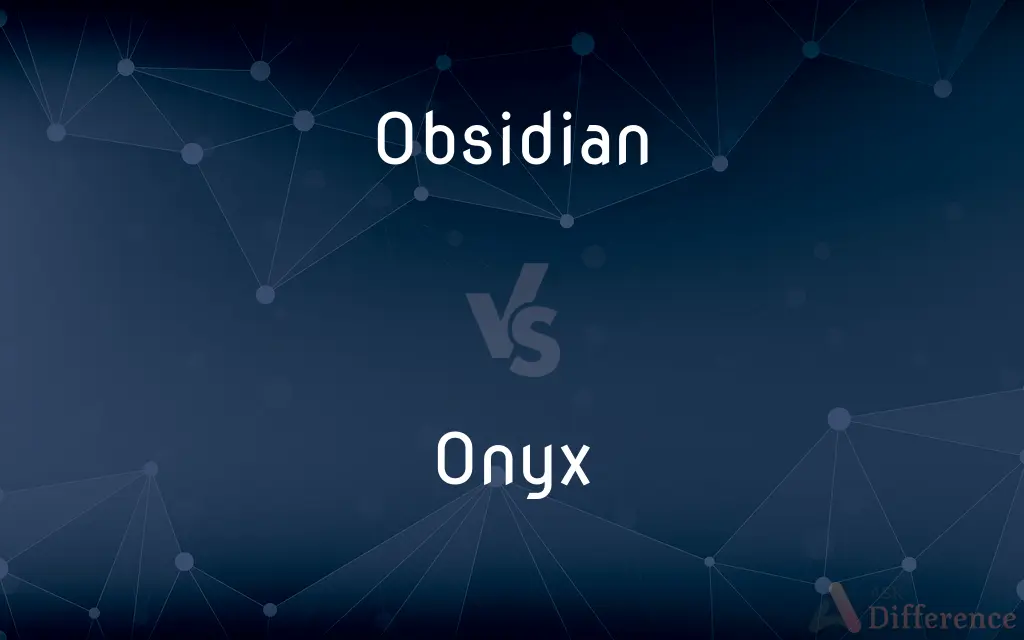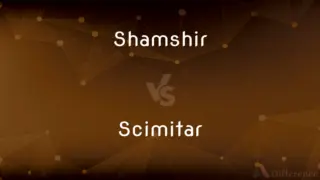Obsidian vs. Onyx — What's the Difference?
Edited by Tayyaba Rehman — By Fiza Rafique — Updated on March 1, 2024
Obsidian is a naturally occurring volcanic glass formed from rapid cooling of viscous lava, while Onyx is a banded variety of chalcedony, a type of quartz, known for its parallel banding of colors.

Difference Between Obsidian and Onyx
Table of Contents
ADVERTISEMENT
Key Differences
Obsidian's origin is igneous, forming from the rapid cooling of felsic lava extruded from a volcano, preventing crystal growth. This process results in a glassy texture and a typically black color, although it can also appear in green, brown, or red, depending on impurities. Obsidian is relatively soft, with a Mohs hardness of 5 to 6, and is sharp enough to have been used historically for cutting and piercing tools.
Onyx, in contrast, is a sedimentary rock, a form of chalcedony quartz that forms in cold water conditions from silica deposits. It is distinguished by its fine layers of color, often contrasting in shades of black and white, although it can be found in a variety of colors including reds and browns. Onyx has a greater hardness, with a Mohs scale rating of 6.5 to 7, making it popular for carved items, jewelry, and decorative objects.
Both stones are valued in jewelry and decorative arts for their beauty and unique appearances, but their origins, composition, and physical properties are quite distinct. Obsidian's glassy luster and sharpness contrast with Onyx's smoother, banded appearance and greater suitability for detailed carving and shaping.
Obsidian is prized for its sharp edges and glossy finish, making it popular for ornamental use and historically for weaponry and tools. Its volcanic origin gives it a rich, glossy appearance that is often used in jewelry and decorative items.
Onyx is favored for its unique banding and elegant appearance, often used in jewelry, cameos, and architectural materials. Its variety of colors and patterns, combined with its durability, make it a versatile material for craftsmen and artists.
ADVERTISEMENT
Comparison Chart
Origin
Volcanic, igneous
Sedimentary, from chalcedony quartz
Color
Primarily black, but can be brown, green, or red
Varied, often banded black and white, but can include reds and browns
Texture
Glassy and smooth
Smooth, with parallel bands of color
Hardness (Mohs Scale)
5-6
6.5-7
Use
Jewelry, decorative items, historical tools/weapons
Jewelry, carved items, decorative objects
Compare with Definitions
Obsidian
A volcanic glass formed from rapid cooling of lava.
Obsidian knives have been used historically for their sharp edges.
Onyx
A banded variety of chalcedony quartz.
Onyx cufflinks are prized for their elegant, banded appearance.
Obsidian
Typically black but can have other colors.
Red obsidian is used in jewelry for its striking appearance.
Onyx
Known for its parallel banding of colors.
Black and white banded onyx vases are decorative and valued.
Obsidian
Glassy texture and appearance.
Obsidian mirrors reflect a clear and sharp image.
Onyx
Varied colors, often layered.
Red onyx is used in jewelry for its depth of color and banding.
Obsidian
Has a relative softness, making it easy to shape.
Obsidian arrowheads are crafted due to the material’s ease of flaking.
Onyx
Harder than obsidian, suitable for carving.
Onyx is often carved into intricate cameos and jewelry pieces.
Obsidian
Used in decorative items and jewelry.
Black obsidian beads are popular in necklaces.
Onyx
Used in jewelry and decorative arts.
Onyx countertops add luxury to interiors with their polished finish and color bands.
Obsidian
Obsidian () is a naturally occurring volcanic glass formed when lava extruded from a volcano cools rapidly with minimal crystal growth. It is an igneous rock.Obsidian is produced from felsic lava, rich in the lighter elements such as silicon, oxygen, aluminium, sodium, and potassium.
Onyx
Onyx primarily refers to the parallel banded variety of the silicate mineral chalcedony. Agate and onyx are both varieties of layered chalcedony that differ only in the form of the bands: agate has curved bands and onyx has parallel bands.
Obsidian
A usually black or banded, hard volcanic glass that displays shiny, curved surfaces when fractured and is formed by rapid cooling of lava.
Onyx
A chalcedony that occurs in bands of different colors and is used as a gemstone, especially in cameos and intaglios.
Obsidian
A slightly bluish black, the color of obsidian glass.
Onyx
(mineral) A banded variety of chalcedony, a cryptocrystalline form of quartz.
Obsidian
A kind of glass produced by volcanoes. It is usually of a black color, and opaque, except in thin splinters.
Onyx
A jet-black color, named after the gemstone.
Obsidian
Acid or granitic glass; usually dark, but transparent in thin pieces
Onyx
Chalcedony in parallel layers of different shades of color. It is used for making cameos, the figure being cut in one layer with the next as a ground.
Onyx
A deep jet-black color.
Onyx
A chalcedony with alternating black and white bands; used in making cameos
Common Curiosities
Which is more durable, Obsidian or Onyx?
Onyx is more durable due to its greater hardness on the Mohs scale.
Are Obsidian and Onyx naturally occurring?
Yes, both are naturally occurring, but they form under different conditions; Obsidian is volcanic, while Onyx forms from silica deposits in cold water.
Can Obsidian and Onyx be used interchangeably in jewelry?
While both can be used in jewelry, their different properties and appearances cater to varied aesthetic and design preferences.
How are Obsidian and Onyx formed?
Obsidian forms from rapid cooling of lava without crystallization, while Onyx forms from layered deposits of silica in cold water.
How can you tell Obsidian and Onyx apart?
Obsidian has a glassy luster and is typically uniform in color, while Onyx features distinct parallel bands of color.
Can the color of Obsidian and Onyx be enhanced?
Yes, both stones can be treated or dyed to enhance or change their colors for decorative purposes.
Why was Obsidian used historically for tools and weapons?
Its sharpness when fractured and ease of shaping made it ideal for creating cutting tools and weapons.
What care is required for Obsidian and Onyx jewelry?
Both should be cleaned gently and protected from harsh chemicals and extreme pressure to avoid scratches or damage.
Is Onyx more expensive than Obsidian?
The value can vary, but Onyx is often more prized for jewelry and decorative items due to its banding and durability.
Do Obsidian and Onyx have any symbolic meanings?
Many cultures attribute symbolic meanings to these stones, often related to protection (Obsidian) and strength or stability (Onyx).
Share Your Discovery

Previous Comparison
Assistance vs. Assistant
Next Comparison
Shamshir vs. ScimitarAuthor Spotlight
Written by
Fiza RafiqueFiza Rafique is a skilled content writer at AskDifference.com, where she meticulously refines and enhances written pieces. Drawing from her vast editorial expertise, Fiza ensures clarity, accuracy, and precision in every article. Passionate about language, she continually seeks to elevate the quality of content for readers worldwide.
Edited by
Tayyaba RehmanTayyaba Rehman is a distinguished writer, currently serving as a primary contributor to askdifference.com. As a researcher in semantics and etymology, Tayyaba's passion for the complexity of languages and their distinctions has found a perfect home on the platform. Tayyaba delves into the intricacies of language, distinguishing between commonly confused words and phrases, thereby providing clarity for readers worldwide.
















































